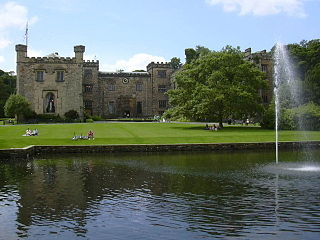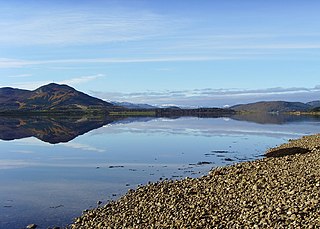
Charles Radclyffe, titular 5th Earl of Derwentwater, was one of the few English participants in the Risings of 1715 and 1745.

HMS Lion or Lyon was a 60-gun fourth rate ship of the line of the Royal Navy, built at Chatham Dockyard to the 1706 Establishment and launched on 20 January 1709.

The Battle of Littleferry took place during the Jacobite rising in 1746, just before the Battle of Culloden. Scottish forces loyal to the British-Hanoverian Government defeated a Scottish Jacobite force.

The Jacobite rising of 1745, also known as the Forty-five Rebellion or simply the '45, was an attempt by Charles Edward Stuart to regain the British throne for his father, James Francis Edward Stuart. It took place during the War of the Austrian Succession, when the bulk of the British Army was fighting in mainland Europe, and proved to be the last in a series of revolts that began in 1689, with major outbreaks in 1708, 1715 and 1719.

Francis Towneley was an English Catholic and supporter of the exiled House of Stuart or Jacobite.

The Skirmish of Tongue was a battle that took place in March 1746 near Tongue in the Scottish Highlands during the Jacobite Rising of 1745.
HMS Hazard was a 14-gun Merlin-class sloop launched in 1744. She was captured in November 1745 by Jacobite forces in Montrose harbour and was sailed to Dunkirk and was renamed Le Prince Charles.
George Mackay of Skibo was a Scottish lawyer, soldier and politician. He fought for the British Government during the Jacobite rising of 1745 and was later a Member of Parliament.
HMS Flamborough was a Royal Navy post ship, launched in 1707 with 24 guns. She was the first Royal Navy vessel to be stationed in South Carolina, holding that position from 1719 to 1721. She was rebuilt as a considerably larger 20-gun vessel in 1727, and was employed during the following decade off Ireland and later on the Jamaica station. After a period in New York she returned to the Carolinas in 1739, patrolling the coast and playing a minor role in the War of Jenkins' Ear. She returned to England in 1745. After undergoing a major repair she was recommissioned under Captain Jervis Porter in April 1746, and served in the North Sea for the following two years. She was sold out of naval service in 1749.
HMS Weazel or Weazle was a 16-gun ship-sloop of the Royal Navy, in active service during the War of the Austrian Succession, the Seven Years' War and the American Revolutionary War. Launched in 1745, she remained in British service until 1779 and captured a total of 11 enemy vessels. She was also present, but not actively engaged, at the Second Battle of Cape Finisterre in 1747.
Antoine Vincent Walsh, was an Irish shipowner and slave trader, operating in Nantes, France; whose family were exiled Jacobites.

The Skirmish of Loch nan Uamh was a conflict that took place on 2 May 1746 and was part of the Jacobite rising of 1745. It was fought by the British Royal Navy against French privateers who were supporting the Jacobite rebels.

The Skirmish of Arisaig took place on 16 May 1746 at Arisaig, Scotland and was the last armed conflict of the Jacobite rising of 1745. It was fought between a British Government force and Jacobites of the Clan Macdonald of Clanranald.

The Battle of Dornoch took place on 20 March 1746 and was part of the Jacobite rising of 1745 in Scotland. However, although recorded in history as a "battle" there was no actual fighting between the two sides. Instead a large rebel Jacobite force advanced on a position held by a force loyal to the British-Hanoverian Government who were taken by surprise and forced into a retreat. The Jacobite advance was coordinated by James Drummond, 3rd Duke of Perth at Dornoch, Sutherland.
Hugh Mackay of Bighouse was a Scottish noble, soldier and a member of the Clan Mackay, a Scottish clan of the Scottish Highlands.
George Mackay, 3rd Lord Reay (1678–1748), was a Scottish noble and chief of the Clan Mackay, a Scottish clan of the Scottish Highlands. During his life the Glorious Revolution took place which directly affected his family and estate, and during his chiefdom he served the British-Hanoverian Government during the Jacobite rising of 1715 and the Jacobite rising of 1745.

HMS Fox was a 20-gun sixth-rate frigate of the Royal Navy. She was constructed at Rotherhithe by John Buxton senior, and launched in 1740. Fox was part of the 1733 Establishment built in response to the upcoming War of the Austrian Succession and spent the majority of her career patrolling for privateers and smaller hostile craft, and protecting convoys. She was active during the Jacobite rising of 1745, contributing troops at the Battle of Prestonpans and protecting the advancing army and supplies of John Cope, before succumbing to a storm off Dunbar on 14 November 1745.
Colonel Richard Augustus Warren, also known as Sir Richard Warren, was an Irish Jacobite soldier who served in the French Irish Brigade and in the Jacobite rising of 1745. He led the naval mission to rescue Charles Edward Stuart from Scotland in 1746.










